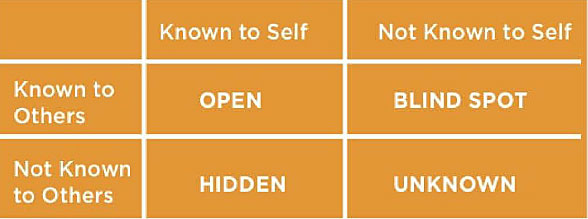Great Leaders Always Check Their Blind Spots
Author: Glyn Jones, CRSP
Posted on Jan 13, 2021
Category:
I remember fondly the days just after I got my driver's license. I was a proud graduate of the CAA driving school in my home town of Aurora. Not only did I learn to keep my hands on the wheel at "10 and 2" (that was before airbags) but also to always check my blind spot before making a lane change. This is good advice for new drivers and good advice for future leaders too! Many people may not even be aware that they have a blind spot. I don't mean a driving blind spot but a leadership blind spot. Not checking your blind spot or not being able to see your blind spot can be a severely career-limiting flaw. Even the most effective leaders have flaws. Unfortunately, many leaders don't know what those flaws are or how to fix or manage them.

So what do I mean by your leadership blind spot? When your colleague tells you that you act in a certain way or your facial expressions or body language are contrary to your messaging and you don't agree with them or you are surprised or perplexed by their comment. then you have not been checking your blind spot. If you know yourself the way others know you, then you have been regularly checking your blind spot.
In reality, some of us have better self-awareness than others. I have said before that a starting point for your leadership development is to "know yourself". I would wager that right now you can easily think of someone you know who has no clue that they act a certain way (e.g., picky, argumentative, gossipy, or loud) even though everybody else around them seems to know it. This lack of personal awareness is what I am referring to as a blind spot. These are the things about ourselves that others can see, but we do not.
When I think about blind spots I am reminded of the quotable quote offered up by Donald Rumsfeld. George W. Bush's Secretary of Defense. Obsessed with going to war with Iraq, he said:
"As we know, there are known knowns; there are things we know we know. We also know there are known unknowns; that is to say we know there are some things we do not know. But there are also unknown unknowns-the ones we don't know we don't know." - Donald Rumsfeld |
Although he did not express it exactly right. Rumsfeld was talking about the United States' blind spot with respect to Saddam Hussein and the Iraqi regime - things that were unknown to the US but known to Iraq. This history, on its own, should teach us that the risk of not managing blind spots can be very detrimental.
What Rumsfeld was talking about is commonly referred to as the Johari Window created by psychologists Joseph Luft and Harrington Ingham. It was designed to help individuals have a better understanding of themselves, and to help them develop better relationships with others.

It is the blind spot area of the matrix we are concerned with. This quadrant represents information that you are not aware of but others are. No one understands this quadrant of the Johari matrix better than Robert Bruce Shaw, a consultant with Princeton Managing Consulting Group in New Jersey. He advocates that, in the leadership arena, there are five common blind spots future leaders need to watch for and manage.
5 Common Blind Spots to Watch for and Manage
1. The strategic thinking blind spot
Many leaders are better at being managers of process than they are at thinking strategically. For many, getting caught in the weeds and the details is their blind spot. Most leaders will over-estimate their capacity to think strategically and often use the word "strategic" as an adjective to describe their plan even when they are actually describing a tactical plan or a simple management process. Instead of thinking strategically, a leader with a strategic capability blind spot spends most of his/her time down in the weeds thinking and talking about operational issues and resolving near-term challenges. In the most extreme cases, the leader can get so lost in operational details that a broader, more strategic view of the future for the operation is never developed.
2. The know-it-all blind spot
 Executives with the know-it-all weakness cannot take others' points of view into consideration, even regarding minor issues. They will likely be guilty of always interrupting people when they're speaking and always seem to find fault in what others are proposing. When given a choice between being right or being effective, the know-it-all leader's preference is to be right. Relying on such false hope and intuition will usually not turn out well. So focused are the "know-it-alls" on the action and discussion and so confident are they in their own abilities, these leaders don't fully explore the options and the associated risks before moving forward with a plan of action.
Executives with the know-it-all weakness cannot take others' points of view into consideration, even regarding minor issues. They will likely be guilty of always interrupting people when they're speaking and always seem to find fault in what others are proposing. When given a choice between being right or being effective, the know-it-all leader's preference is to be right. Relying on such false hope and intuition will usually not turn out well. So focused are the "know-it-alls" on the action and discussion and so confident are they in their own abilities, these leaders don't fully explore the options and the associated risks before moving forward with a plan of action.
3. The unbalanced blind spot
The unbalanced blind spot is inability to balance the "what" with the "how". This creates risks with respect to outcome. Some leaders with this particular flaw place excessive emphasis on results over process. This makes it hard for them to see that they may be inadvertently creating a "win at all costs" mentality within their organizations. Other leaders susceptible o this blind spot focus too much on how well their employees work together and don't place enough emphasis on delivering results. In both cases, these leaders fail to recognize the need for balance between what an organization needs to achieve and how it goes about achieving it.
4. The assumption blind spot
It is the wisest person who knows for sure that you should never assume anything about anyone. Many leaders assume that all others are just like them when in fact statistically this is simply not possible and not true. These leaders unfortunately go into many situations with a flawed understanding of how others think about any given situation and about the values ascribed. This assumption blind spot creates a tendency for them to think that others are like themselves, particularly in regards to what motivates them, how they make decisions, and what their preferences are in dealing with conflict. The assumption blind spot often leads to bad decisionmaking and a weakening of relationships.
5. The "been-there-done-that" blind spot
This blind spot has its genesis in the thinking that past experiences are always relevant and helpful in solving current problems. It is true that past experience is valuable and can be used to shape thinking; however, many with this blind spot take it too far. New challenges are viewed as being similar to past challenges and addressed as such. This may include applying proven methods that simply do not fit. This approach can lead to catastrophic failure if the new challenge is actually quite different than those faced in the past. The blind spot may develop because the leader wrongly assesses their past success and promotion as having been as a result of how they did things in the past instead of the more general assessment of inherent potential for doing great things in the future.
While it is true that every leader is individually and uniquely flawed, there are a few tools that all leaders can use to see past the blind spots that are holding them back. Future leaders need to apply the necessary thinking and uncover their blind spots if they are to optimize their capacity.
How to Uncover Your Blind Spots
Seek feedback from others
 The advice of others can be an all-important warning system for you. Ask people who are close to you to give you honest feedback on your behaviours. Ask them to tell you when they see you doing something that jeopardizes your capacity to maintain trust and build engagement with the team and others. Listen to their advice and take action! This will help to shrink this "blind" spot.
The advice of others can be an all-important warning system for you. Ask people who are close to you to give you honest feedback on your behaviours. Ask them to tell you when they see you doing something that jeopardizes your capacity to maintain trust and build engagement with the team and others. Listen to their advice and take action! This will help to shrink this "blind" spot.
Open up about behaviors in general
If you know you do things that may be seen by others as negative or that have the capacity to diminish trust or degrade engagement. challenge yourself to acknowledge this and explore the root of this behaviour. Share your thoughts with someone you trust and encourage them to ask you how it's going with that habit. You will be surprised what transparency and accountability can do in terms of reducing your "blind spot" of behaviours.
Build a strong team
Surrounding yourself with excellence is never a bad idea. Having a diverse team of smart people around you who are willing to engage in debates and difficult conversations on the best path forward is a leading indicator of blind spot compression or elimination.
Monitor yourself
Great leaders know themselves. Focus on increasing your self-awareness and looking out for how you react in different situations. This can reduce the number and types of unknown knowns. We are all capable of increasing the level of our self-control and in doing so managing these blind spots.

While not commonly used in leadership development circles, the Johari Window can help anyone analyze and manage their behaviours. This will help you shrink the size of your blind spot, and hidden and unknown windows which, in turn, will increase the size of your "open" window. That will put you on a path towards increasing capacity to lead others.